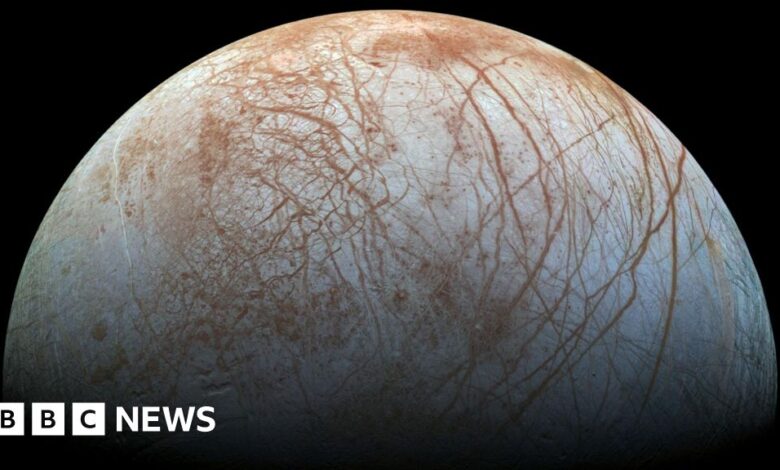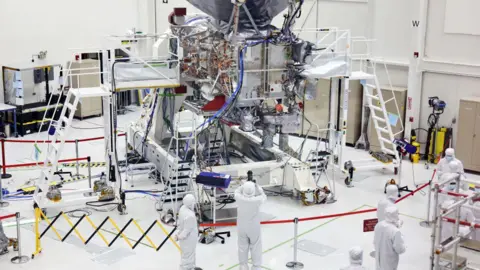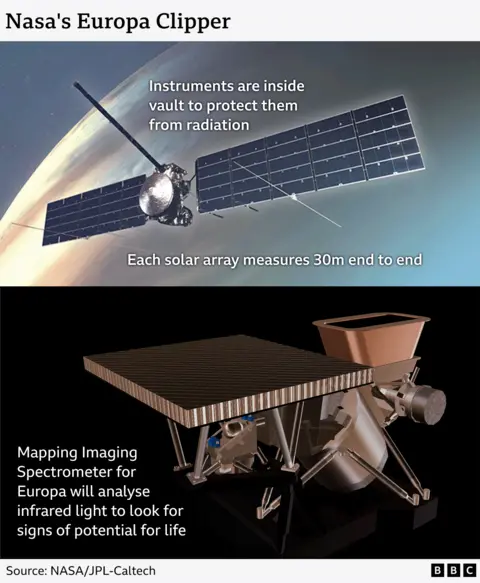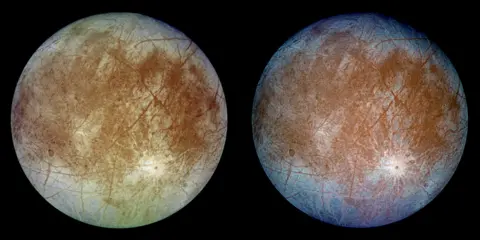Countdown to the mission to hunt for alien life on the mysterious icy moon

 Getty Images
Getty ImagesIn a few hours, a spacecraft will lift off from Florida to search for signs of alien life.
Its destination is Europa, an extremely mysterious moon orbiting the distant planet Jupiter.
Trapped beneath its icy surface could be a vast ocean with twice as much water as Earth.
The Europa Clipper spacecraft will chase a European mission that left last year, but using a space piggyback, it will overtake and reach its destination first.
That’s not due until 2030 but what it finds could change what we know about life in the solar system.
The moon is five times brighter than ours
Years in the making, Europa Clipper’s launch was delayed at the last minute after Hurricane Milton devastated Florida this week.
The spacecraft was brought indoors for shelter, but after checking the launch pad at Cape Canaveral for damage, engineers have now cleared liftoff at 12:06 local time (1706 BST ) on October 14.
Mark Fox-Powell, a planetary microbiologist at the Open University, said: “If we detect life very far from the Sun, it would mean that Earth has a separate origin of life.
“That’s incredibly important, because if that happens twice in our solar system, it means life is really widespread,” he said.
Located 628 million kilometers from Earth, Europa is only slightly larger than our moon, but the similarities end there.
If it were in our sky, it would be five times brighter because water ice would reflect more sunlight.
Its icy crust is up to 25 kilometers thick and underneath may be a vast ocean of salt water. There may also be chemicals that are components of simple life.

Scientists first realized Europa could support life in the 1970s when, looking through telescopes in Arizona, they saw frozen water.
The Voyager 1 and 2 spacecraft took the first close-up photos, and then in 1995, Nasa’s Galileo spacecraft flew by Europa and captured some extremely puzzling photos. They show a surface full of dark reddish brown cracks; The cracks may contain salts and sulfur compounds that could support life.
The James Webb Telescope has since taken images of what may be plumes of water erupting 100 miles (160 km) above the lunar surface.
But none of those missions have been close enough to Europa for long enough to really understand it.
Fly over the waters
Now, scientists hope that instruments on Nasa’s Clipper spacecraft will map almost the entire moon, as well as collect dust particles and fly through water plumes.
Britney Schmidt, associate professor of earth and atmospheric sciences at Cornell University in the US, has helped design an onboard laser that can see through ice.
 NASA Institute/JPL-Caltech/SETI
NASA Institute/JPL-Caltech/SETI“I’m excited to understand Europa’s plumbing system. Where is the water? Europa has ice versions of Earth’s subduction zones, magma chambers and tectonics – we will try to observe those areas and map them,” she said.
Her instrument, called Reason, was tested in Antarctica.
But unlike on Earth, all the equipment on Clipper will be exposed to huge amounts of radiation, which Professor Schmidt said is a “major concern”.
The spacecraft will fly past Europa about 50 times, and each time it will be bombarded with radiation equivalent to one million X-rays.
Professor Schmidt explained: “The majority of electronic equipment is in a vault that is strictly shielded to avoid radiation.”
The spacecraft is the largest ever built to visit a planet and has a long journey ahead. Traveling 1.8 billion miles, it will orbit both Earth and Mars to propel itself further toward Jupiter in a so-called slingshot effect.

It can’t carry enough fuel to propel itself all the way, so it will depend on the gravitational momentum of Earth and Mars.
It will pass JUICE, the European Space Agency spacecraft that will also visit Europa on its way to another moon of Jupiter called Ganeymede.
When Clipper approaches Europa in 2030, it will turn its engines back on to carefully maneuver into the right orbit.
 NASA/JPL/DLR
NASA/JPL/DLRSpace scientists are cautious when it comes to the chances of discovering life – there is no expectation that they will find human-like creatures or animals
“We’re looking for habitability potential and you need four things – liquid water, a heat source and organic material. Ultimately, those three components need to be stable over a long enough period of time for something to happen,” explains Michelle Dougherty, professor of space physics at Imperial College in London.
And they hope that if they can better understand the ice surface, they will know where to land on future missions.
An international team of scientists from NASA, the Jet Propulsion Laboratory and the Johns Hopkins Applied Physics Laboratory will oversee the adventure.
At a time when there is a space launch almost every week, this mission promises something different, Professor Fox-Powell suggested.
“No profit is made. This is about exploration and curiosity, and pushing the boundaries of our understanding of our place in the universe,” he said.





